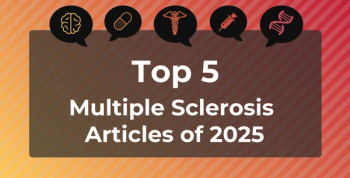
Can Biomarkers Help Pinpoint the Right Treatment for Chronic Spontaneous Urticaria?
Key Takeaways
- Patients with CSU have an elevated risk of anxiety and depression, necessitating comprehensive management strategies.
- Research is focused on identifying biomarkers and clinical characteristics to predict treatment responses.
Identifying specific biomarkers and clinical characteristics is crucial for predicting a patient's response to both existing and emerging treatments for chronic spontaneous urticaria, thereby moving toward a more personalized approach to care.
Patients with
A higher prevalence of psychiatric conditions, such as anxiety and depression, and a reduced quality of life are common among patients with CSU.2 Awareness of these issues and related sleep disturbances can help clinicians better support their patients.
The economic and health care burdens of CSU are likely underestimated, partly due to unplanned medical visits.1 While omalizumab (Xolair; Roche/Novartis) is a standard treatment for patients 12 and older whose hives aren't controlled by H1 antihistamines, emerging options such as rilzabrutinib (PRN1008; Sandoz), show promise for those who don't respond to omalizumab.3,4
As more treatments for nonresponders become available, there is a growing need to identify biomarkers that can predict which treatment will be most effective.1 A review of published literature was conducted to evaluate the role of various clinical and laboratory markers in predicting treatment responses to both current and new therapies for CSU.
Previous research on omalizumab's effectiveness initially found no link between baseline serum IgE levels and patient response. However, later studies revealed that low IgE levels (typically below 18 IU/mL) are associated with a reduced response, while elevated IgE levels correlate with a complete response, defined as a Urticaria Activity Score during a 7 day period (UAS7) of 0.
Despite this, a standardized IgE cutoff for distinguishing responders has not been established. A recent study proposed specific baseline IgE cutoffs (42.5 and 59.5 IU/mL) with high sensitivity (76.6%) and specificity (93%) for predicting a complete response. This suggests that while total serum IgE is a promising biomarker, a standardized value is needed for clinical practice.
In a 182 participant study, a small group of patients (less than 10%) with type IIb autoimmune urticaria, who were identified by 3 positive tests, including an autologous serum skin test which showed lower baseline IgE, higher disease activity, and higher anti-thyroid peroxidase (TPO) antibodies. Each of these positive tests was linked to a slower or nonresponse to omalizumab.
Though previously seen as a separate condition, evidence now suggests an overlap between type IIb autoimmune and autoallergic urticaria, with the presence of both IgG and IgE autoantibodies predicting a poor response to omalizumab. Because the required specialized assays are difficult to use in routine clinical practice, researchers are exploring standard laboratory tests. A machine learning approach successfully identified a patient cluster similar to those with type IIb autoimmune urticaria using routine tests like positive IgG anti-TPO and antinuclear antibody tests, suggesting a new way to predict treatment outcomes.
Low levels of basophils and eosinophils are established indicators of severe CSU, with basophil counts rising as symptoms improve. Research suggests that both the number and function of basophils can predict a patient's response to omalizumab. For example, a higher baseline basophil count is linked to a better response, while a lower count and reduced basophil activation are associated with nonresponse.
Eosinopenia is also tied to nonresponse and the need for higher doses of omalizumab. However, the use of routine basophil counts as a predictive tool is limited by inconsistent accuracy and a lack of standardized techniques. Functional basophil assays may provide a more precise method for predicting treatment success in CSU.
Eosinophil activation in CSU triggers the coagulation cascade, which increases endothelial cell activation and thrombin generation. While elevated D-dimer levels are known markers of disease activity and antihistamine nonresponse, their link to omalizumab response is debated. Some studies show a connection, while others do not. A recent study found that high D-dimer levels before omalizumab treatment were associated with a 5-fold higher chance of needing a larger dose, suggesting that endothelial cell activation is a crucial area for further research into treatment response.
Cyclosporine is a fourth-line treatment for CSU at doses up to 5 mg/kg that's unresponsive to high-dose omalizumab. Some research, though not yet in clinical guidelines, suggests that patients with autoimmune type IIb CSU, indicated by a positive basophil histamine release assay, may respond well to cyclosporine. Studies also propose that responders may have higher disease activity, low IgE, and normal D-dimer levels at baseline, with a normal D-dimer specifically linked to a complete response.
Though various factors may influence treatment response in CSU, the evidence is often conflicting. Some studies link poor response to treatments such as omalizumab and cyclosporine with a patient's sex, comorbid autoimmune diseases, angioedema, depression, or obesity, while large-scale studies having found no such correlation. Age has not been shown to affect treatment response.
Studies are exploring new biomarkers to predict omalizumab response in CSU. Research found that patients who responded to treatment had significantly higher baseline levels of Galectin 9+ eosinophils.
Additionally, other studies found that myeloid and mast cell progenitors, identified by flow cytometry, also predict treatment response. Interestingly, a separate study found no link between plasma protein changes and omalizumab response. This suggests that cellular markers may be more reliable predictors of omalizumab's effectiveness than plasma proteins.
New treatments for CSU are emerging, including biosimilars for anti-IgE therapies that could improve patient access. Open-label studies show promise for dupilumab, remibrutinib, and barzolvolimab, though more research is needed to compare them directly with existing options. In contrast, benralizumab was discontinued after it failed to show a benefit over placebo in a phase 2b trial.
In a study of dupilumab for CSU, patients who were either omalizumab-naive or had not tolerated omalizumab showed improved UAS7 scores. While improvements for those with previous omalizumab exposure were not statistically significant, omalizumab-naive patients saw significant improvements. The study also found that dupilumab's benefits develop gradually over time, unlike the rapid but plateauing response of omalizumab. Given that dupilumab blocks IL-4/IL-13, it may be especially effective for patients with coexisting atopic conditions such as atopic dermatitis, suggesting that patient-specific factors should guide treatment selection.
Remibrutinib, a phase 3 drug for CSU, showed strong efficacy by significantly reducing UAS7 scores in patients, including those who previously failed omalizumab therapy, regardless of baseline IgE levels. An in vitro study supports its potential by showing it inhibits mast cell activation, even in nonresponders to omalizumab.
Another treatment, barzolvolimab, is in phase 2 development. As an anti-KIT monoclonal antibody, it depletes mast cells, which could mitigate various pathways of mast cell degranulation. The final role of these new therapies in CSU management will be determined as clinical guidelines are updated.
“Increased understanding of the nuance of disease pathogenesis and treatment outcomes in CSU suggests that we advance from a focus upon endotypes towards a paradigm of predicting individual response,” study authors concluded.
References
- Ridge K, Ahmad R, Moran B, et al. Towards personalised therapy in chronic spontaneous urticaria: advancing from endotype to clinical response. Clin Exp Allergy. Published online July 2, 2025. doi:10.1111/cea.70100
- Cetinkaya PO, Kurt BO, Aktaran A, Aksu A, Altunay IK. Sleep disturbance and psychological stress: two interconnected conditions in chronic spontaneous urticaria. Sisli Etfal Hastan Tip Bul. 2025;59(1):35-43. Published 2025 Mar 18. doi:10.14744/SEMB.2024.54871
- Starting treatment for chronic hives can be the first step to stopping the itch. Xolair. February 25, 2025. Accessed August 11, 2025.
https://www.xolair.com/chronic-spontaneous-urticaria/about-chronic-hives/treating-chronic-hives.html - Santoro C. Rilzabrutinib reduces itch and hives in antihistamine-resistant chronic spontaneous urticaria. The American Journal of Managed Care®. May 6, 2025. Accessed August 11, 2025.
https://www.ajmc.com/view/rilzabrutinib-reduces-itch-and-hives-in-antihistamine-resistant-chronic-spontaneous-urticaria
Newsletter
Stay ahead of policy, cost, and value—subscribe to AJMC for expert insights at the intersection of clinical care and health economics.







































